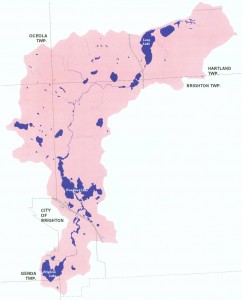
The Brighton Lake subwatershed covers 23 square miles in southeast Livingston County, extending from the headwaters of South Ore Creek downstream to the Brighton Lake impoundment just south of the City of Brighton.
Following a two-year planning process that involved local communities, county agencies, key business interests, citizens groups, and other stakeholders, the Brighton Lake Subwatershed Management Plan was approved by MDEQ in August 2002. The Plan sets forth a comprehensive, long-term effort to restore and protect the water quality of the subwatershed with the goal of attaining the Brighton Lake TMDL for non-point phosphorus pollution. Approval of the Plan by MDEQ and EPA makes the Brighton Lake communities eligible to compete for implementation funds to address problems such as high nutrient loading, stream bank stabilization, soil erosion, and other activities identified in the Plan.
The Plan includes the following list of prioritized subwatershed concerns/needs as developed by the working group:
- Water quality monitoring programs and data
- Community land use planning and standards
- Excessive impervious surface generation
- Stormwater mitigation, management, and runoff issues
- Watershed education
Sources and causes associated with these priority concerns are presented in the Plan, along with a list of eleven goals and objectives. An Action Matrix identifies specific potential actions that are recommended to achieve the goals and objectives. The actions range from managerial practices (e.g., new and revised ordinances) to structural practices (constructed wetlands and wet detention basins) to vegetative practices (e.g., vegetated riparian buffers) to improving monitoring programs and data collection. The combination of actions taken will be determined by each community based on cost, acceptability, and sustainability.
HRWC has completed a MDEQ-funded grant to implement some of the Plan’s recommendations. This grant has served to improve public education on watershed issues, increase adoption of residential BMPs for reduction of nonpoint source phosphorus pollution (run-off), and help local governments to prioritize and implement changes to their codes and ordinances.
How can you help or get involved with implementing the Brighton Lake Subwatershed Management Plan?
- Let us know if you know of any areas in particular need of streambank restoration, stormwater controls (such as detention ponds, infiltration basins, ect.) or if you area a property owner who would like to restore wetlands on your land. We can help you create a site plan and search for funding.
- If you are interested in getting involved in a citizens group, we may be able to connect you with other interested people.



